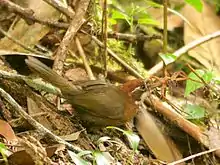White-throated oxylabes
The white-throated oxylabes (Oxylabes madagascariensis) is a species of passerine bird that is endemic to Madagascar. It is the only species placed in the genus Oxylabes. Formerly considered as a member of the Old World warbler family Sylviidae, it has been moved to the family Bernieridae — the Malagasy warblers.[2] Its natural habitat is subtropical or tropical moist lowland forests.[1]
| White-throated oxylabes | |
|---|---|
 | |
| Scientific classification | |
| Domain: | Eukaryota |
| Kingdom: | Animalia |
| Phylum: | Chordata |
| Clade: | Dinosauria |
| Class: | Aves |
| Order: | Passeriformes |
| Family: | Bernieridae |
| Genus: | Oxylabes Sharpe, 1870 |
| Species: | O. madagascariensis |
| Binomial name | |
| Oxylabes madagascariensis (Gmelin, JF, 1789) | |
| Synonyms | |
|
Hypositta perdita | |
Taxonomy
In 1760 the French zoologist Mathurin Jacques Brisson included a description and an illustration of the white-throated oxylabes in the third volume of his Ornithologie based on a specimen collected on the island of Madagascar. He used the French name Le rossignol de Madagascar and the Latin name Luscinia madagascariensis.[3] Although Brisson coined Latin names, these do not conform to the binomial system and are not recognised by the International Commission on Zoological Nomenclature.[4] When in 1789 the German naturalist Johann Friedrich Gmelin revised and expanded Carl Linnaeus's Systema Naturae he included the white-throated oxylabes based on Brisson's description. He placed it with the wagtails in the genus Motacilla and coined the binomial name Motacilla madagascariensis.[5] The white-throated oxylabes is now the only species placed in the genus Oxylabes that was introduced in 1870 by the English ornithologist Richard Bowdler Sharpe.[6][7] The genus name is from Ancient Greek oxulabēs meaning "quick at seizing".[8] The species is monotypic: no subspecies are recognised.[7]
In 2013, genetic studies determined that the Bluntschli's vanga (also known as short-toed nuthatch-vanga), a species described in 1996 from two specimens collected in 1931, was actually this species. The specimens were both juveniles in a poorly known brown plumage.[9]
Description
The white-throated oxylabes is a large warbler 17–18 cm (6.7–7.1 in) in length. It has short wings, long legs and a long stout bill. The upperparts are dark olive-brown with a rufous top and side of head. It has a narrow white supercilium and a white chin and throat. The underparts are dark brown. The sexes are alike.[10]
References
- BirdLife International (2016). "Oxylabes madagascariensis". IUCN Red List of Threatened Species. 2016: e.T22716763A94509959. doi:10.2305/IUCN.UK.2016-3.RLTS.T22716763A94509959.en. Retrieved 12 November 2021.
- Cibois, Alice; Slikas, Beth; Schulenberg, Thomas S.; Pasquet, Eric (2001). "An endemic radiation of Malagasy songbirds is revealed by mitochondrial DNA sequence data". Evolution. 55 (6): 1198–1206. doi:10.1554/0014-3820(2001)055[1198:AEROMS]2.0.CO;2. PMID 11475055.
- Brisson, Mathurin Jacques (1760). Ornithologie, ou, Méthode Contenant la Division des Oiseaux en Ordres, Sections, Genres, Especes & leurs Variétés (in French and Latin). Vol. 3. Paris: Jean-Baptiste Bauche. pp. 401–402, Plate 22 Fig. 1. The two stars (**) at the start of the section indicates that Brisson based his description on the examination of a specimen.
- Allen, J.A. (1910). "Collation of Brisson's genera of birds with those of Linnaeus". Bulletin of the American Museum of Natural History. 28: 317–335.
- Gmelin, Johann Friedrich (1789). Systema naturae per regna tria naturae : secundum classes, ordines, genera, species, cum characteribus, differentiis, synonymis, locis (in Latin). Vol. 1, Part 2 (13th ed.). Lipsiae [Leipzig]: Georg. Emanuel. Beer. p. 952.
- Sharpe, R. Bowdler (1870). "Contributions to the ornithology of Madagascar". Proceedings of the Zoological Society of London: 384–401 [386].
- Gill, Frank; Donsker, David; Rasmussen, Pamela, eds. (January 2023). "Grassbirds, Donacobius, tetrakas, cisticolas, allies". IOC World Bird List Version 13.1. International Ornithologists' Union. Retrieved 23 May 2023.
- Jobling, James A. (2010). The Helm Dictionary of Scientific Bird Names. London: Christopher Helm. p. 387. ISBN 978-1-4081-2501-4.
- Fjeldså, Jon; Mayr, Gerald; Jønsson, Knud A.; Irestedt, Martin (2013). "On the true identity of Bluntschli's Vanga Hypositta perdita Peters, 1996, a presumed extinct species of Vangidae" (PDF). Bull. BOC. 133 (1): 72–75. Retrieved 12 August 2016.
- Bairlein, F. (2006). "Family Sylviidae (Old World Warblers)". In del Hoyo, J.; Elliott, A.; Sargatal, J. (eds.). Handbook of the Birds of the World. Vol. 11: Old Word flycatchers to Old World Warblers. Barcelona, Spain: Lynx Edicions. pp. 492-712 [644]. ISBN 978-84-96553-06-4.
